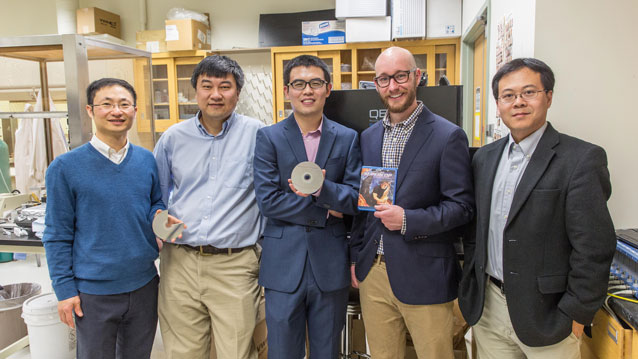EVANSTON, Ill. --- Who knew Blu-ray discs were so useful? Already one of the best ways to store high-definition movies and television shows because of their high-density data storage, Blu-ray discs also improve the performance of solar cells — suggesting a second use for unwanted discs — according to new research from Northwestern University.
An interdisciplinary research team has discovered that the pattern of information written on a Blu-ray disc -- and it doesn’t matter if it’s Jackie Chan’s “Police Story 3: Supercop” or the cartoon “Family Guy” -- works very well for improving light absorption across the solar spectrum. And better yet, the researchers know why.
“We had a hunch that Blu-ray discs might work for improving solar cells, and, to our delight, we found the existing patterns are already very good,” said Jiaxing Huang, a materials chemist and an associate professor of materials science and engineering in the McCormick School of Engineering and Applied Science. “It’s as if electrical engineers and computer scientists developing the Blu-ray technology have been subconsciously doing our jobs, too.”
Blu-ray discs contain a higher density of data than DVDs or CDs, and it is this quasi-random pattern, perfected by engineers over decades for data storage, that, when transferred to the surface of solar cells, provides the right texture to improve the cells’ light absorption and performance.
Working with Cheng Sun, an associate professor of mechanical engineering at McCormick, Huang and his team tested a wide range of movies and television shows stored on Blu-ray discs, including action movies, dramas, documentaries, cartoons and black-and-white content, and found the video content did not matter. All worked equally well for enhancing light absorption in solar cells.
The findings are published today (Nov. 25) in the journal Nature Communications.
In the field of solar cells, it is known that if texture is placed on the surface of a solar cell, light is scattered more effectively, increasing a cell’s efficiency. Scientists have long been searching for the most effective texture with a reasonable manufacturing cost.
The Northwestern researchers have demonstrated that a Blu-ray disc’s strings of binary code 0s and 1s, embedded as islands and pits to store video information, give solar cells the near-optimal surface texture to improve their absorption over the broad spectrum of sunlight.
In their study, the researchers first selected the Jackie Chan movie “Police Story 3: Supercop.” They replicated the pattern on the active layer of a polymer solar cell and found the cell was more efficient than a control solar cell with a random pattern on its surface.
“We found a random pattern or texture does work better than no pattern, but a Blu-ray disc pattern is best of all,” Huang said. “Then I wondered, why did it work? If you don’t understand why, it’s not good science.”
Huang puzzled over the question of why for some time. One day, his wife, Shaorong Liu, a database engineer at IBM, suggested it likely had something to do with data compression. That was the insight Huang needed.
Huang and Sun then turned to McCormick colleague Dongning Guo, an expert in information theory, to investigate this idea. Guo is an associate professor of electrical engineering and computer science.
The researchers looked closely at the data processing algorithms in the Blu-ray standard and noted the algorithms serve two major purposes:
• Achieving as high a degree of compression as possible by converting the video signals into a seemingly random sequence of 0s and 1s; and
• Increasing error tolerance by adding controlled redundancy into the data sequence, which also limits the number of consecutive 0s and 1s.
These two purposes, the researchers said, have resulted in a quasi-random array of islands and pits (0s and 1s) with feature sizes between 150 and 525 nanometers. And this range, it turns out, works quite well for light-trapping applications over the entire solar spectrum.
The overall broadband absorption enhancement of a Blu-ray patterned solar cell was measured to be 21.8 percent, the researchers report.
“In addition to improving polymer solar cells, our simulation suggests the Blu-ray patterns could be broadly applied for light trapping in other kinds of solar cells,” Sun said.
“It has been quite unexpected and truly thrilling to see new science coming out of the intersection of information theory, nanophotonics and materials science,” Huang said.
The National Science Foundation supported the research.
The paper is titled “Repurposing Blu-ray Movie Discs as Quasi-random Nanoimprinting Templates for Photon Management.”
In addition to Huang, Guo and Sun, other authors of the paper are Alexander J. Smith (co-first author) and Chen Wang (co-first author), both of Northwestern.


